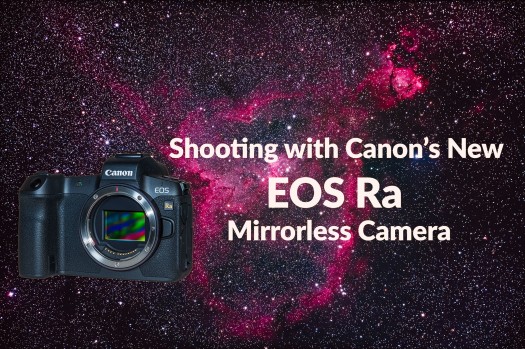
I had the chance to test out an early sample of Canon’s new EOS Ra camera designed for deep-sky photography.
Once every 7 years astrophotographers have reason to celebrate when Canon introduces one of their “a” cameras, astronomical variants optimized for deep-sky objects, notably red nebulas.
In 2005 Canon introduced the ground-breaking 8-megapixel 20Da, the first DLSR to feature Live View for focusing. Seven years later, in 2012, Canon released the 18-megapixel 60Da, a camera I still use and love.
Both cameras were cropped-frame DSLRs.
Now in 2019, seven years after the 60Da, we have the newly-released EOS Ra, the astrophoto version of the 30-megapixel EOS R released in late 2018. The EOS R is a full-frame mirrorless camera with a sensor similar to what’s in Canon’s 5D MkIV DSLR.
Here, I present a selection of sample images taken with the new EOS Ra.
Details on its performance is at my “first-look” review at Sky and Telescope magazine’s website.
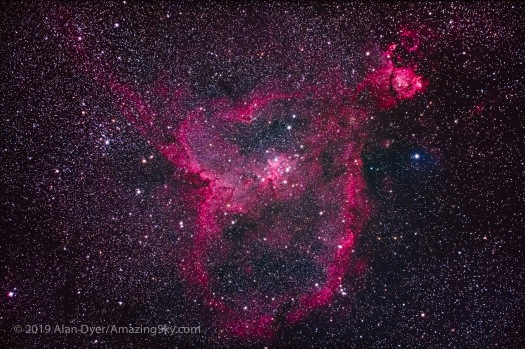
Both versions of the EOS R have identical functions and menus.
The big difference is that the EOS Ra, as did Canon’s earlier “a” models, has a factory-installed filter in front of the sensor that transmits more of the deep red “hydrogen-alpha” wavelength emitted by glowing nebulas.
Normal cameras suppress much of this deep-red light as a by-product of their filters cutting out the infra-red light that digital sensors are very sensitive to, but that would not focus well.
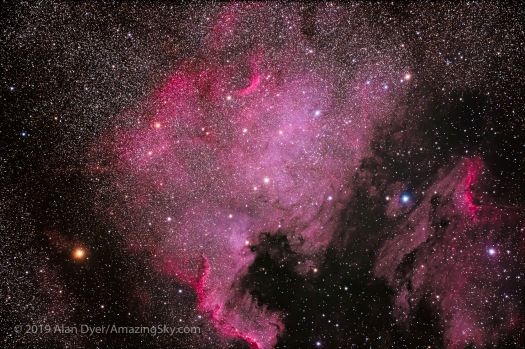
I was sent an early sample of the EOS Ra, and earlier this autumn also had a sample of the stock EOS R.
Both were sent for testing so I could prepare a test report for Sky and Telescope magazine. The full test report will appear in an upcoming issue.
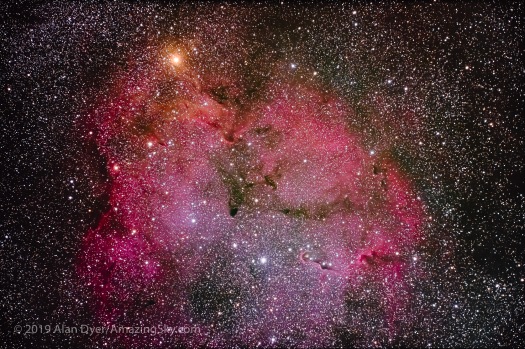
But my “first-look” review can be found here on the Sky and Telescope website.
Please click thru for comments on:
• How the Ra compares to previous “a” models and third-party filter-modified cameras
• How the Ra works for normal daylight photography
• Noise levels compared to other cameras
• Features unique to the EOS Ra, such as 30x Live View focusing
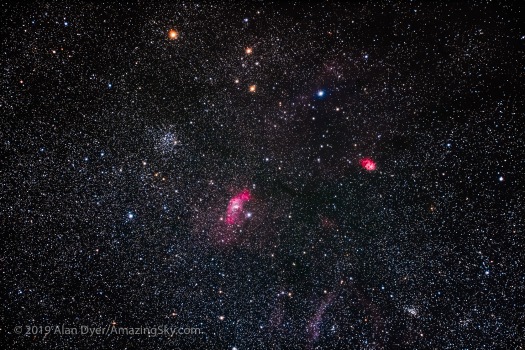
UPDATE — November 25, 2019
As part of further testing I shot the Heart and Soul Nebulas in Cassiopeia through my little Borg 77mm f/4 astrograph with both the EOS Ra and my filter-modified 5D MkII (modified years ago by AstroHutech) to compare which pulled in more nebulosity. It looked like a draw.
Both images are single 8-minute exposures, taken minutes apart and developed identically in Adobe Camera Raw, but adjusted for colour balance to equally neutralize the sky background. The histograms look similar. Even so, the Ra looks a little redder overall. But keep in mind a sky or nebula can be made to appear any shade of red you like in processing.
The question is which camera shows more faint nebulosity?
The modified 5D MkII has always been my favourite camera for this type of astrophotography, picking up more nebulosity than other “a” models I’ve tested, including the Nikon D810a.
But in this case, I’d say the EOS Ra is performing as well as, if not better than the 5D MkII. How well any third-party modified camera you buy now performs will depend which, if any, filter the modifier installs in front of the sensor. So your mileage will vary.
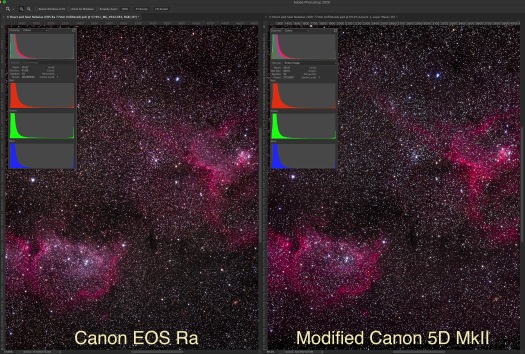
For most of my other testing I shot through my much-prized Astro-Physics Traveler, a 105mm aperture f/6 apochromatic refractor on the Astro-Physics Mach1 mount.
To connect the EOS Ra (with its new RF lens mount) to my existing telescope-to-camera adapter and field flattener lens I used one of Canon’s EF-EOS R lens adapters.

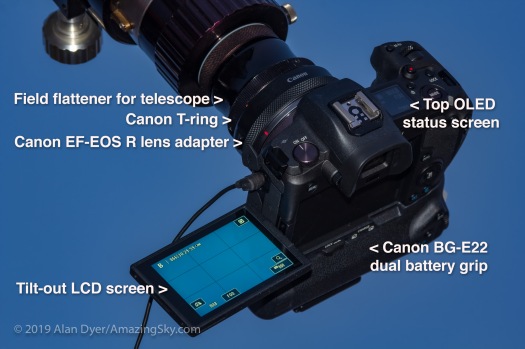
The bottom line is that the EOS Ra works great!
It performs very well on H-alpha-rich nebulas and has very low noise. It will be well-suited to not only deep-sky photography but also to wide-field nightscape and time-lapse photography, perhaps as Canon’s best camera yet for those applications.
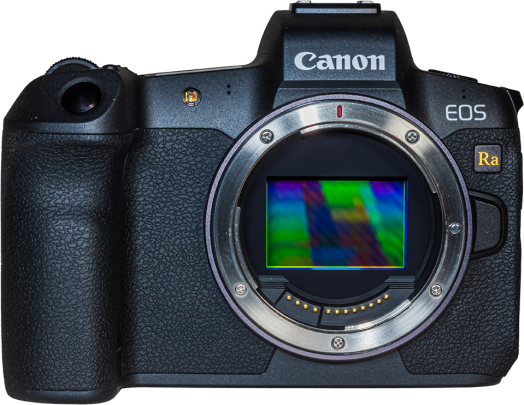
WHAT ABOUT THE PRICE?
The EOS Ra will sell for $2,500 US, a $700 premium over the cost of the stock EOS R. Some complain. Of course, if you don’t like it, you don’t have to buy it. This is not an upgrade being forced upon you.
As I look at it, it is all relative. When Nikon’s astronomy DSLR, the 36 Mp D810a, came out in 2015 it sold for $3,800 US, $1,300 more than the EOS Ra. It was, and remains a fine camera, if you can find one. It is discontinued.
A 36 Mp cooled and dedicated CMOS astro camera, the QHY367, with the same chip as the D810a, goes for $4,400, $1,900 more than the Ra. Yes, it will produce better images I’m sure than the EOS Ra, but deep-sky imaging is all it can do. At a cost, in dollars and ease of use.
And yes, buying a stock EOS R and having it modified by a third party costs less, and you’ll certainly get a good camera, for $300 to $400 less than an Ra. But …
• The EOS Ra has a factory adjusted white balance for ease of “normal” use — no need to buy correction filters. So there’s a $$ saving there, even if you can find clip-in correction filters for the EOS R — you can’t.
• And the Ra retains the sensor dust cleaning function. Camera modifier companies remove it or charge more to reinstall it.
• And the 30x live view magnification is very nice.
• The EOS Ra also carries a full factory warranty.
Do I wish the EOS Ra had some other key features? Sure. A mode to turn all menus red would be nice. As would an intervalometer built-in, one that works with the Bulb Timer to allow sequences of programmed multi-minute exposures. Both could be added in with a firmware update.
And providing a basic EF-EOS R lens adapter in the price would be a welcome plus, as one is essential to use the EOS Ra on a telescope.
That’s my take on it. I’ll be buying one. But then again I bought the 20Da, twice!, and the 60Da, and I hate to think what I paid for those much less capable cameras.

BONUS TEST — The RF 15-35mm L Lens
Canon is also releasing an impressive series of top-class RF lenses for their R mirrorless cameras. The image below is an example astrophoto with the new RF 15-35mm f/2.8 L zoom lens, an ideal combination of focal lengths and speed for nightscape shooting.
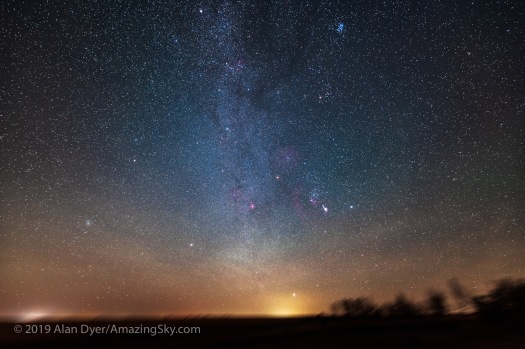
Below is a further set of stacked and processed images with the RF 15-35mm L lens, taken in quick succession, at 15mm, 24mm, and 35mm focal lengths, all shot wide open at f/2.8. The EOS Ra was on the Star Adventurer tracker (as below) to follow the stars.
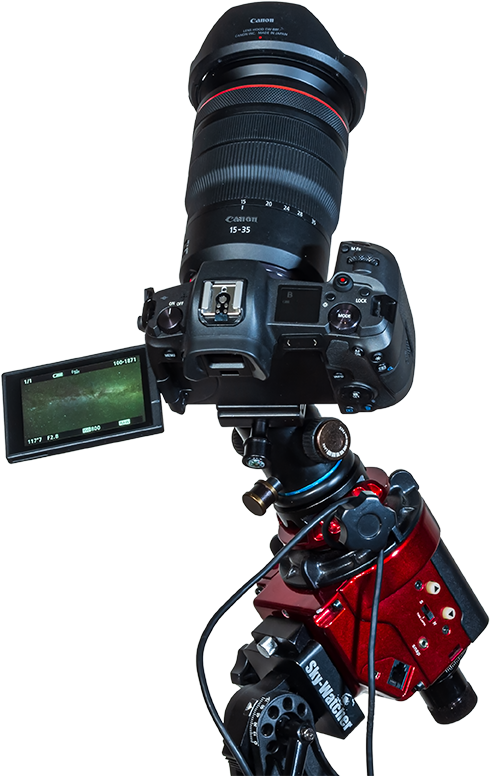
Click or tap on the images below to view a full-resolution version for closer inspection.
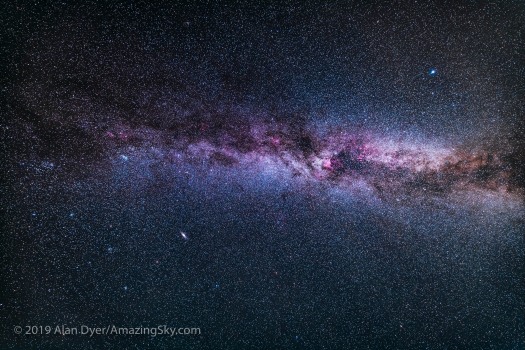
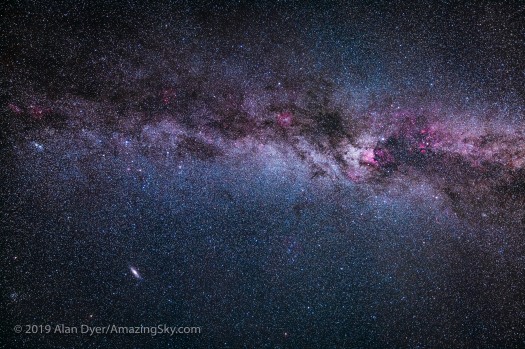
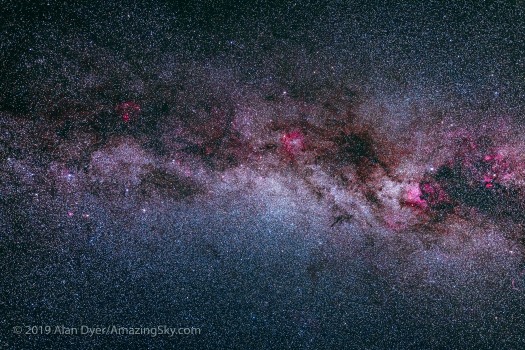
The RF 15-35mm lens performs extremely well at 15mm exhibiting very little off-axis aberrations at the corners.
Off-axis aberrations do increase at the longer focal lengths but are still very well controlled, and are much less than I’ve seen on my older zoom and prime lenses in this focal length range.
The RF 15-35mm is a great complement to the EOS Ra for wide-field Milky Way images.
I was impressed with the new EOS Ra. It performs superbly for astrophotography.
Again, click through to Sky and Telescope for “first look” details on the test results.
— Alan, November 6, 2019 / UPDATED Nov 25, 2019 / © 2019 AmazingSky.com


Hi Alan
Thanks very much for your great articles have read several. I really think you should do a review/comparison with the new Canon EOS RP (or R) and the other usual suspects 6d or Nikons 759 / Z6 etc. as I‘m sure many will end up with the RP given its attractive pricing. Indeed I have already seen comments here and there rating it quite positively but would be nice to see one of your in depth reviews maybe compared to Nikon z6 -as I’m concerned about that pesky Canon iso variancy 😉 though some say low light on RP is great, but I’ve seen evidence that it eats detail upwards of 6-12800…
Would you recommend going the Canon mirrorless or Nikon Route for Astro at the moment?
I’ve not used an Rp and by rights it should be less noisy but from what I understand its battery life will be short which is a concern. I shot for 4 hours of long exposures last night with the Ra and the battery was 50% at dawn. And I like the top screen read outs of the R and other higher priced mirrorless cameras. Very handy when on a scope. These days I’d go Mirrorless — I’ve little need for an optical viewfinder — too hard to look through on a scope.
Thanks for reply
Would you recommend I’d go Nikon z6 or Canon Rp (or R) then? Especially if doing untracked Astro and lucky imaging mainly?
Thanks
Hello, I could not recommend one or the other and if it’s planetary imaging you are after you’d be better off with a dedicated planetary camera. But either mirrorless will be fine for Nightscapes.